Brown Rot of Stone Fruits
Brown rot is a fungal disease of stone fruit caused by Monilinia fructicola. It may cause serious damage to fruit during wet seasons. Early infections appear as blossom blight or shoot dieback. Later infections appear as a rot of ripening fruit on the tree and in storage.
Symptoms:
Blossom Blight: Infected blossoms wilt, shrivel and become covered with greyish mold. Petals may appear light brown or water-soaked, similar to frost injury. Blighted blossoms do not produce fruit.
The amount of blossom blight directly affects the amount of fruit rot. Dead blossoms may stick to spurs and twigs until harvest, providing a source of spores for the fruit rot phase.
Twig Blight and Canker: On peaches and apricots, the infection may spread to twigs, causing brownish, oval cankers that may girdle and kill twigs. Gumming may also occur on infected twigs.
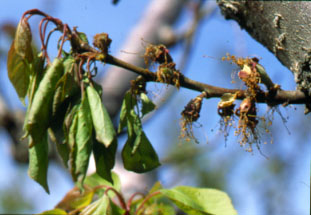 |
| Shoot blight of apricot caused by brown rot |
Fruit Rot: Fruit rot first appears as small, circular brown spots that increase rapidly in size causing the entire fruit to rot. Greyish spores appear in tufts on rotted areas. Infected fruit eventually turn into shriveled, black mummies that may drop or remain attached to the tree through the winter. Brown rot can be serious on injured fruit such as cherries split by rain.
Brown rot can spread after harvest and has the potential to cause severe post-harvest losses. Mature fruit can decay within 48 hours under warm conditions.
Note that botrytis rot is also common on cherries, and symptoms appear similar to brown rot. Correct diagnosis of the rot present is an important consideration when selecting fungicides.
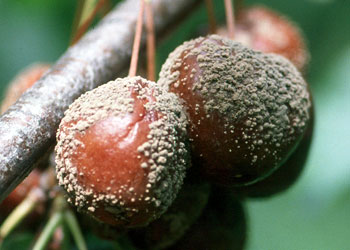 |
| Brown rot sporulating on sweet cherry fruit |
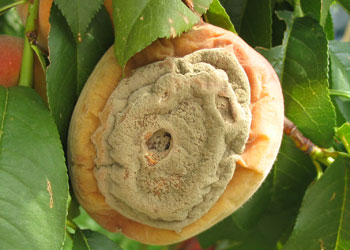 |
| Brown rot on peach fruit |
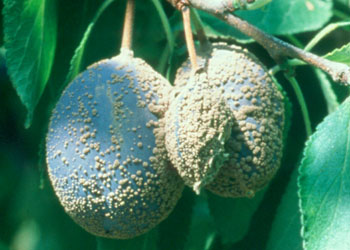 |
| Brown rot on Italian prune |
Life Cycle:
Overwintering: The fungus overwinters in mummified fruit on the ground or in the tree, and in twig cankers.
Spring infection: Prolonged wet weather during bloom may result in extensive blossom infection. Two types of spores are produced in spring which can infect blossoms. Conidia are produced on cankers and mummified fruit in the tree. Apothecia (small mushroom like structures) form on fruit mummies lying on the ground. The apothecia discharge ascospores during the bloom period, but don't contribute to fruit infection later in season. Mummified fruit left on the trees are thought to be the main source of initial inoculum in the B.C. interior.
Secondary Infection: Spores produced on blighted blossoms provide a source of infection for ripening fruit. Infected fruit become covered with greyish spores which spread by wind and rain to healthy fruit. Insects may also contribute to spread of brown rot spores.
Conditions for infection: Brown rot is more of a problem during wet seasons. Prolonged wet weather during bloom may result in extensive blossom infection. The length of wet periods required for blossom infection depends upon the temperature. The chart below illustrates the length of wet period required for blossom infection to occur at various temperatures.
|
Temperature
|
Hours of Wet Required
For Blossom Infection |
|---|---|
|
26 ºC
|
2
|
|
21 ºC
|
3
|
|
16 ºC
|
4
|
|
7 ºC
|
6-7
|
|
4 ºC
|
11-12
|
Disease Management
Cultural Control
- Orchard sanitation: Remove and destroy fruit mummies (dried up fruit hanging on the tree) when pruning. Prune out any cankered or dead twigs as they are found. Removing rotten fruit from the tree will reduce initial inoculum. Removing fallen fruit from the ground is less practical, but may be an option in small blocks or for organic growers. Although sanitation alone is not sufficient to control brown rot in most commercial orchards, it is a good IPM control strategy. Sanitation will decrease inoculum levels, which will improve the effectiveness of fungicide sprays. Fungicidal control may not be as good as desired when disease pressure is very high.
- Pruning: Some cherry varieties such as Lapins tend to produce large clusters of fruit. Brown rot is more likely to develop in large clusters due to the difficulty of obtaining good fungicide coverage and slower drying of fruit in the middle of the clusters. When pruning, remove excessive branches to allow for increased air flow and shorten current season's growth to reduce fruit cluster formation.
- Avoid injuring or bruising fruit at harvest. Pick only sound fruit. Discard fruit with brown spots or rot. Dispose of culls and rotted fruit promptly by burying. Pre-cool and keep fruit in cold storage until it reaches destination.
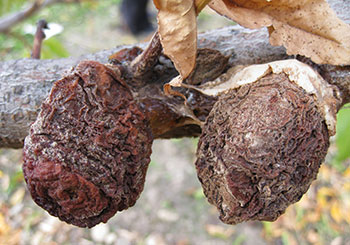 |
| Remove mummified peach fruit after harvest or during winter pruning to help control brown rot. |
Chemical Control
Refer to the BC Tree Fruit Production Guide for available fungicides. Follow the product labels for application instructions and precautions.
- Blossom - Orchards with a history of brown rot require one or more fungicide sprays to protect blossoms. Spray when first blossoms open. If wet weather occurs repeat spray at 50 per cent bloom and at full bloom.
- Immature Fruit - Immature fruit are more resistant to brown rot than blossoms and mature fruit, hower they can be infected under wet conditions. Fruitlets are most susceptible prior to shuck fall. Consider protecting fruitlets in orchards with a history of brown rot problems.
- Ripening fruit- Apply a brown rot fungicide when the fruit changes colour and a second spray just before picking. Additional sprays may be needed with wet weather. Control insects that cause fruit injury.
- Mature Fruit - Ripe fruit, especially apricots and peaches, are very susceptible to brown rot infection. A pre-harvest application of a brown rot fungicide immediately before harvest (1-3 days) is needed to provide these fruit with an adequate shelf life. Select fungicides that have a minimum pre-harvest interval of three or less days.
- Post-harvest - A post-harvest fungicide treatment is available for packinghouse use. Scholar (fludioxonil) is registered for post-harvest use on all stone fruit for control of brown rot as well as botrytis, penicillium and rhizopus rots.
Fungal resistance to fungicides is a high risk for many brown rot fungicides. Alternate fungicides with different modes of action, or use registered tank mixes to reduce the risk of resistance developing in your orchard.
Updated July, 2018
Related Links
More Information
AgriService BC
Have a question? Call or email us.
Toll Free: 1-888-221-7141
E-mail: AgriServiceBC@gov.bc.ca
